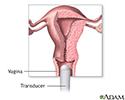Transvaginal ultrasound
Endovaginal ultrasound; Ultrasound - transvaginal; Fibroids - transvaginal ultrasound; Vaginal bleeding - transvaginal ultrasound; Uterine bleeding - transvaginal ultrasound; Menstrual bleeding - transvaginal ultrasound; Infertility - transvaginal ultrasound; Ovarian - transvaginal ultrasound; Abscess - transvaginal ultrasound
Transvaginal ultrasound is a test used to look at a woman's uterus, ovaries, tubes, cervix and pelvic area.
Cervix
The cervix is the lower end of the womb (uterus). It is at the top of the vagina. It is about 2 inches (5 centimeters) long. The cervical canal pa...

Transvaginal means across or through the vagina. The ultrasound probe will be placed inside the vagina.
How the Test is Performed
You will lie down on a table with your knees bent. Your feet may be held in stirrups.
You will be given a probe, called a transducer, to place into the vagina. The probe is covered with a condom and a gel.
- The probe sends out sound waves, which reflect off body structures. A computer receives these waves and uses them to create a picture.
- The ultrasound technician or doctor can see the picture on a TV monitor.
- The health care provider will move the probe around the area to see the pelvic organs.
In some cases, a special transvaginal ultrasound method called saline infusion sonography (SIS) may be needed to more clearly view the uterus.
How to Prepare for the Test
You will be asked to undress, usually from the waist down. A transvaginal ultrasound is done with your bladder empty or partly filled.
How the Test will Feel
The test is most often painless, although some women may have mild discomfort from the pressure of the probe. Only a small part of the probe is placed into the vagina.
Why the Test is Performed
Transvaginal ultrasound may be done for the following problems:
-
Abnormal findings on a physical exam, such as cysts,
fibroid
tumors, or other growths
Fibroid
Uterine fibroids are tumors that grow in a woman's womb (uterus). These growths are typically not cancerous (benign).
 ImageRead Article Now Book Mark Article
ImageRead Article Now Book Mark Article - Abnormal vaginal bleeding and menstrual problems
- Certain types of infertility
-
Ectopic pregnancy
Ectopic pregnancy
An ectopic pregnancy is a pregnancy that occurs outside the womb (uterus). It is life-threatening to the mother.
 ImageRead Article Now Book Mark Article
ImageRead Article Now Book Mark Article - Pelvic pain
Transvaginal ultrasound is also used during pregnancy .
Transvaginal ultrasound is also used du...
A pregnancy ultrasound is an imaging test that uses sound waves to create a picture of how a baby is developing in the womb. It is also used to chec...

Normal Results
The pelvic structures or fetus is normal.
What Abnormal Results Mean
An abnormal result may be due to many conditions. Some problems that may be seen include:
- Birth defects
- Cancers of the uterus, ovaries, vagina, and other pelvic structures
- Infection, including pelvic inflammatory disease
- Growths in or around the uterus and ovaries (such as cysts or fibroids)
- Twisting of the ovaries
Risks
There are no known harmful effects of transvaginal ultrasound on humans.
Unlike traditional x-rays, there is no radiation exposure with this test.
References
Coleman RL, Ramirez PT, Gershenson DM. Neoplastic diseases of the ovary: Screening, benign and malignant epithelial and germ cell neoplasms, sex-cord stromal tumors. In: Lentz GM, Lobo RA, Gershenson DM, Katz VL, eds. Comprehensive Gynecology . 6th ed. Philadelphia, PA: Elsevier Mosby; 2012:chap 33.
Katz VL. Benign gynecologic lesions: vulva, vagina, cervix, uterus, oviduct, ovary, ultrasound imaging of pelvic structures. In: Lentz GM, Lobo RA, Gershenson DM, Katz VL, eds. Comprehensive Gynecology . 6th ed. Philadelphia, PA: Elsevier Mosby; 2012:chap 18.
-
Ultrasound in pregnancy - illustration
The ultrasound has become a standard procedure used during pregnancy. It can demonstrate fetal growth and can detect increasing numbers of conditions in the fetus including meningomyelocele, congenital heart disease, kidney abnormalities, hydrocephalus, anencephaly, club feet, and other deformities. Ultrasound does not produce ionizing radiation and is considered a very safe procedure for both the mother and the fetus.
Ultrasound in pregnancy
illustration
-
Female reproductive anatomy - illustration
External structures of the female reproductive anatomy include the labium minora and majora, the vagina and the clitoris. Internal structures include the uterus, ovaries and cervix.
Female reproductive anatomy
illustration
-
Uterus - illustration
The uterus is a hollow muscular organ located in the female pelvis between the bladder and rectum. The ovaries produce the eggs that travel through the fallopian tubes. Once the egg has left the ovary it can be fertilized and implant itself in the lining of the uterus. The main function of the uterus is to nourish the developing fetus prior to birth.
Uterus
illustration
-
Transvaginal ultrasound - illustration
Transvaginal ultrasound is a method of imaging the genital tract in females. A hand held probe is inserted directly into the vagina. The probe is moved within the vaginal cavity to scan the pelvic structures, while ultrasound pictures are viewed on a monitor. The test can be performed to evaluate women with infertility problems, abnormal bleeding, sources of unexplained pain, congenital malformations of the uterus and ovaries, and possible tumors and infection.
Transvaginal ultrasound
illustration
-
Ultrasound in pregnancy - illustration
The ultrasound has become a standard procedure used during pregnancy. It can demonstrate fetal growth and can detect increasing numbers of conditions in the fetus including meningomyelocele, congenital heart disease, kidney abnormalities, hydrocephalus, anencephaly, club feet, and other deformities. Ultrasound does not produce ionizing radiation and is considered a very safe procedure for both the mother and the fetus.
Ultrasound in pregnancy
illustration
-
Female reproductive anatomy - illustration
External structures of the female reproductive anatomy include the labium minora and majora, the vagina and the clitoris. Internal structures include the uterus, ovaries and cervix.
Female reproductive anatomy
illustration
-
Uterus - illustration
The uterus is a hollow muscular organ located in the female pelvis between the bladder and rectum. The ovaries produce the eggs that travel through the fallopian tubes. Once the egg has left the ovary it can be fertilized and implant itself in the lining of the uterus. The main function of the uterus is to nourish the developing fetus prior to birth.
Uterus
illustration
-
Transvaginal ultrasound - illustration
Transvaginal ultrasound is a method of imaging the genital tract in females. A hand held probe is inserted directly into the vagina. The probe is moved within the vaginal cavity to scan the pelvic structures, while ultrasound pictures are viewed on a monitor. The test can be performed to evaluate women with infertility problems, abnormal bleeding, sources of unexplained pain, congenital malformations of the uterus and ovaries, and possible tumors and infection.
Transvaginal ultrasound
illustration
Review Date: 5/16/2016
Reviewed By: Irina Burd, MD, PhD, Associate Professor of Gynecology and Obstetrics at Johns Hopkins University School of Medicine, Baltimore, MD. Review provided by VeriMed Healthcare Network. Also reviewed by David Zieve, MD, MHA, Isla Ogilvie, PhD, and the A.D.A.M. Editorial team.




